仁爱版八年级英语下册第六单元备课教案
- 格式:doc
- 大小:61.00 KB
- 文档页数:4
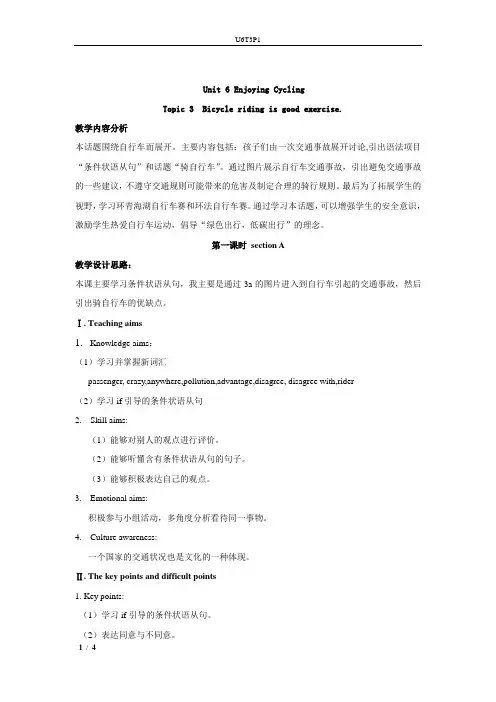
Unit 6 Enjoying CyclingTopic 3 Bicycle riding is good exercise.教学内容分析本话题围绕自行车而展开。
主要内容包括:孩子们由一次交通事故展开讨论,引出语法项目“条件状语从句”和话题“骑自行车”。
通过图片展示自行车交通事故,引出避免交通事故的一些建议,不遵守交通规则可能带来的危害及制定合理的骑行规则。
最后为了拓展学生的视野,学习环青海湖自行车赛和环法自行车赛。
通过学习本话题,可以增强学生的安全意识,激励学生热爱自行车运动,倡导“绿色出行,低碳出行”的理念。
第一课时section A教学设计思路:本课主要学习条件状语从句,我主要是通过3a的图片进入到自行车引起的交通事故,然后引出骑自行车的优缺点。
Ⅰ. Teaching aims1.Knowledge aims:(1)学习并掌握新词汇passenger, crazy,anywhere,pollution,advantage,disagree, disagree with,rider(2)学习if引导的条件状语从句2. Skill aims:(1)能够对别人的观点进行评价。
(2)能够听懂含有条件状语从句的句子。
(3)能够积极表达自己的观点。
3. Emotional aims:积极参与小组活动,多角度分析看待同一事物。
4. Culture awareness:一个国家的交通状况也是文化的一种体现。
Ⅱ. The key points and difficult points1. Key points:(1)学习if引导的条件状语从句。
(2)表达同意与不同意。
2. Difficult points:正确运用条件状语从句中主句与从句的时态。
Ⅲ. Learning strategies1. 联系时间状语从句来学习条件状语从句。
2. 学会先听懂文章的大意然后完成任务。
3. 虚心听取别人的意见,但也要勇于开口表达自己的观点。
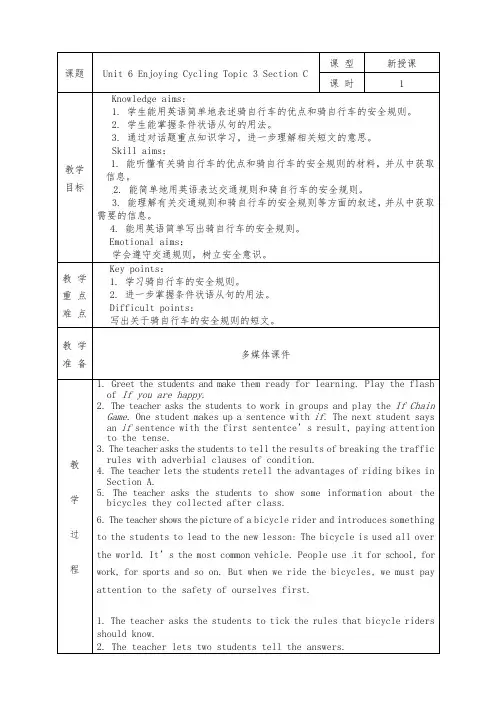
课题Unit 6 Enjoying Cycling Topic 3 Section C 课型新授课课时 1教学目标Knowledge aims:1. 学生能用英语简单地表述骑自行车的优点和骑自行车的安全规则。
2. 学生能掌握条件状语从句的用法。
3. 通过对话题重点知识学习,进一步理解相关短文的意思。
Skill aims:1. 能听懂有关骑自行车的优点和骑自行车的安全规则的材料,并从中获取信息。
2. 能简单地用英语表达交通规则和骑自行车的安全规则。
3. 能理解有关交通规则和骑自行车的安全规则等方面的叙述,并从中获取需要的信息。
4. 能用英语简单写出骑自行车的安全规则。
Emotional aims:学会遵守交通规则,树立安全意识。
教学重点难点Key points:1. 学习骑自行车的安全规则。
2. 进一步掌握条件状语从句的用法。
Difficult points:写出关于骑自行车的安全规则的短文。
教学准备多媒体课件教学过程1. Greet the students and make them ready for learning. Play the flash of If you are happy.2. The teacher asks the students to work in groups and play the If Chain Game. One student makes up a sentence with if. The next student says an if sentence with the first sententce’s result, paying attention to the tense.3. The teacher asks the students to tell the results of breaking the trafficrules with adverbial clauses of condition.4. The teacher lets the students retell the advantages of riding bikes inSection A.5. The teacher asks the students to show some information about thebicycles they collected after class.6. The teacher shows the picture of a bicycle rider and introduces something to the students to lead to the new lesson: The bicycle is used all over the world. It’s the most common vehicle. People use it for school, for work, for sports and so on. But when we ride the bicycles, we must pay attention to the safety of ourselves first.1. The teacher asks the students to tick the rules that bicycle riders should know.2. The teacher lets two students tell the answers.3.The teacher lets the students read the passage and find out the topic sentence for each paragraph.4.The teacher asks two students to tell the topic sentences.5.The teacher asks the students to match the topic sentence with each paragraph based on the activity above, and then write a title for the passage of 1a. Finish 1b.6. The teacher asks the students to tell the answers.7.The teacher asks the students to read the passage again and underline the new words.Teach the new words truck, signal, reflector,injury by showing the pictures of them. Teach the new word safety by showing the word safe to the students. Teach pay attention to, notice, in case of, and in a word by showing their Chinese meanings.1. The teacher plays the recording sentence by sentence.2. The teacher plays the recording without stopping.3. The teacher asks the students to learn in groups to find out the difficult points in the conversation. At last let them sum up the main points of the passage.4. The teacher makes a summary to explain the key points anddifficult points to the students.(1) pay attention to (doing) sth.(2) use sth. for (doing) sth.(3) in case of(4) in a word5. The teacher lets the students read the first paragraph of 1a, and then answer the question: What do people use bicycles for?6. The teacher lets the students read the second paragraph of 1a, and then answer the question: Why is bicycle riding a good exercise?7. The teacher lets the students read the third paragraph of 1a, and then answerthe last three questions of 1c.8. The teacher asks two students to tell the answers.1. The teacher asks the students to read the words in the box of 2 and the sentences of2. Teach the new phrase look out.2. The teacher asks the students to complete the sentences with the correct forms of the words in the box.3. The teacher asks two students to tell the answers.4. The teacher asks the students to read the complete sentences.5. The teacher lets the students retell the passage of 1a according to thesentences of 2.6. The teacher lets the students look at the pictures of 3. Then ask themto talk about the pictures with the given phrases in groups.7. The teacher lets the students tick the ones that bicycle riders shoulddo and cross the ones they shouldn’t do.8. The teacher lets the students try writing down the sentences with thegiven words according to the pictures.9. The teacher asks the students to show their sentences.10. The teacher asks the students to write a passage according to thesentences.11. The teacher asks some students to report the passages1. The teacher asks the students to make a survey in groups and interviewtheirgroup mat es about the bicycle traffic accidents around them and the traffic rules they know.2. The teacher asks the students to write down the report.3. The teacher asks the representatives of each group to report theirresults.4. The teacher sums up the activities. The group with the most and correcsentences wins. Tell the students the best way to be safe is to becareful.5. The teacher shows the summary to the students.6. The teacher assigns homework:(1) Review the summary after class.(2) Ask the students to write a passage about the bicycle safety.(3) Collect some information about cycling race to prepare for SectionD.作业布置完成同步练习课堂总结The students know about that bicycle riding is good exercise, but it’s also very dangerous if we don’t follow the traffic rules, so we must be careful when riding.。
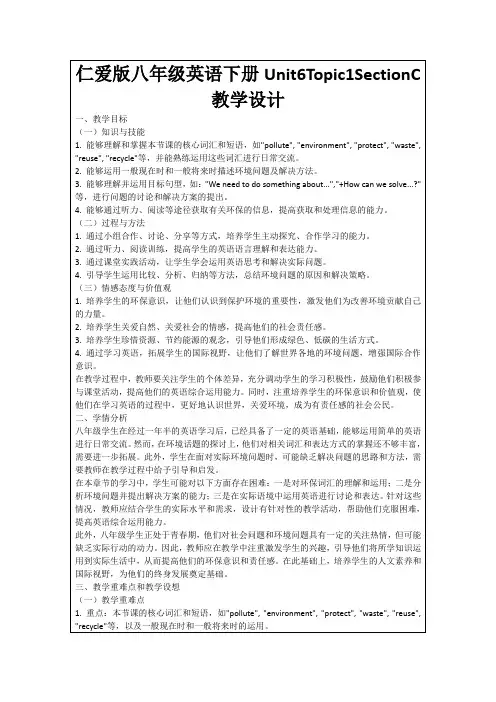
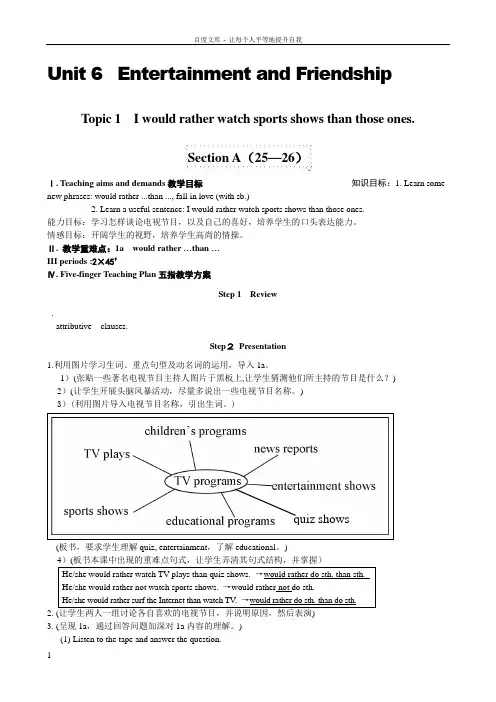
Unit 6 Entertainment and FriendshipTopic 1 I would rather watch sports shows than those ones.Section A (25—26)Ⅰ. Teaching aims and demands 教学目标 知识目标:1. Learn some new phrases: would rather ...than ..., fall in love (with sb.)2. Learn a useful sentence: I would rather watch sports shows than those ones.能力目标:学习怎样谈论电视节目,以及自己的喜好,培养学生的口头表达能力。
情感目标:开阔学生的视野,培养学生高尚的情操。
Ⅱ. 教学重难点:1a would rather …than … III periods :2×45’Ⅳ. Five-finger Teaching Plan 五指教学方案Step 1 Review.attributive clauses.Step 2 Presentation1.利用图片学习生词、重点句型及动名词的运用,导入1a 。
1)(张贴一些著名电视节目主持人图片于黑板上,让学生猜测他们所主持的节目是什么?) 2)(让学生开展头脑风暴活动,尽量多说出一些电视节目名称。
) 3)(利用图片导入电视节目名称,引出生词。
)(板书,要求学生理解quiz, entertainment ,了解educational 。
)He/she would rather watch TV plays than quiz shows. →would rather do sth. than sth. He/she would rather not watch sports shows. →would rather not do sth.He/she would rather surf the Internet than watch TV . →would rather do sth. than do sth. 2. (让学生两人一组讨论各自喜欢的电视节目,并说明原因,然后表演) 3. (呈现1a ,通过回答问题加深对1a 内容的理解。
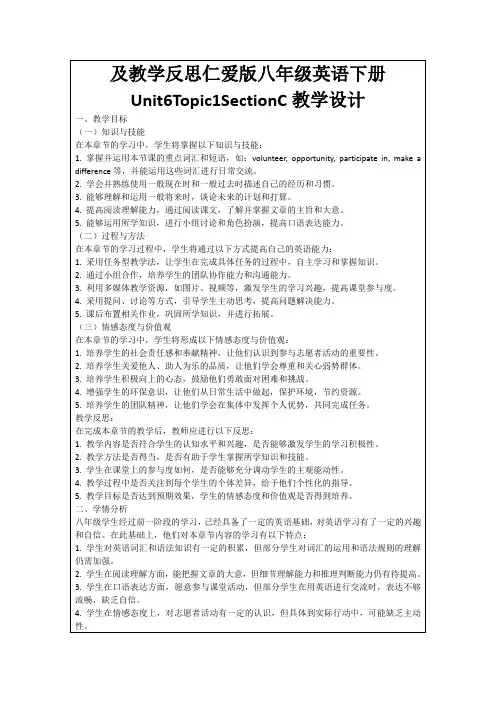
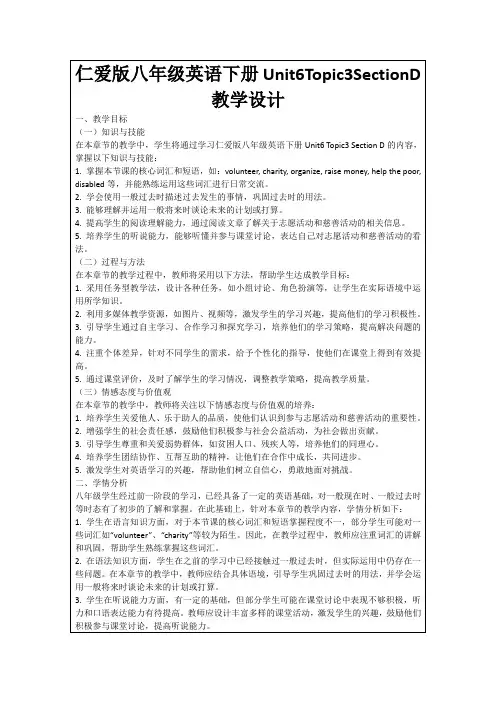
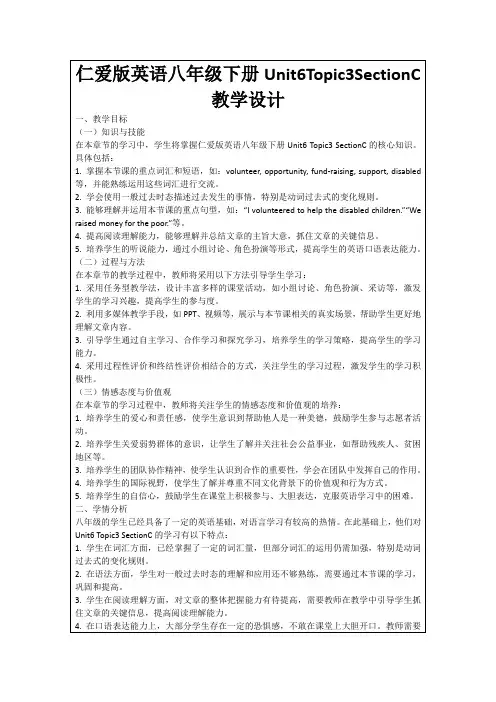
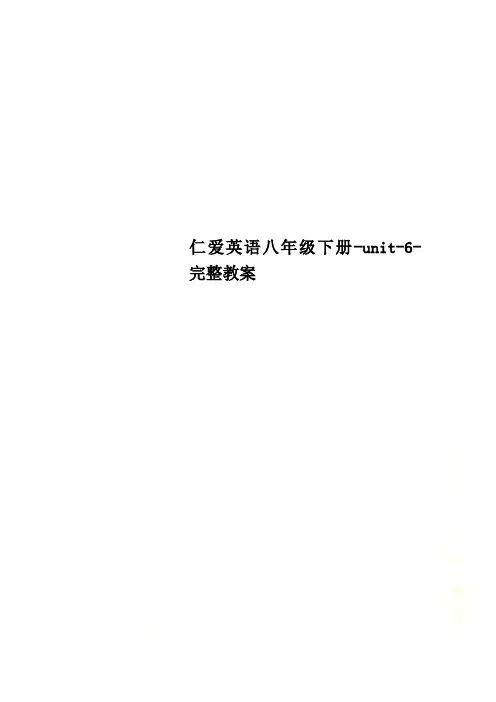
仁爱英语八年级下册-unit-6-完整教案仁爱英语八年级下册-unit-6-完整教案教案-孔迪-unit6 topic1 -2017春季第4周(Topic 1 I have some exciting news totell you.)Section A学习目标1、词汇:field, proper, mount, vehicle, airline, price, total, partner2、短语:spring field trip, a three-day visit, find out, decide on sth.3、句型:(1)I have some exciting news to tell you!(2)We’re going on a three-day visit to Mount Tai.(3)But it will take us a few days to get there by bike.(4)Let’s find out some information about the cost.重难点1、活用所学的词汇及短语。
2. 学习谈论旅游,激发对旅游的爱好及丰富业余生活。
学习流程Step1. ReviewTalk :What do usually do when you feel sad or lonely?Step 2. Presentation1.Watch a short video of visiting Sanya.Group work:1.Read the words together.Help each other in group.2. 突袭单词:根据首字母提示填空。
1.Which v___________ do you like best ,bus ,car or train?2.Can you see a sheep eating grass in the green f__________?3.If you add 30 and 45 the t___________ is 75.4.We d__________ to go there by airplane.5. What’s the p________ of you book?3. 组长展示学习成果。
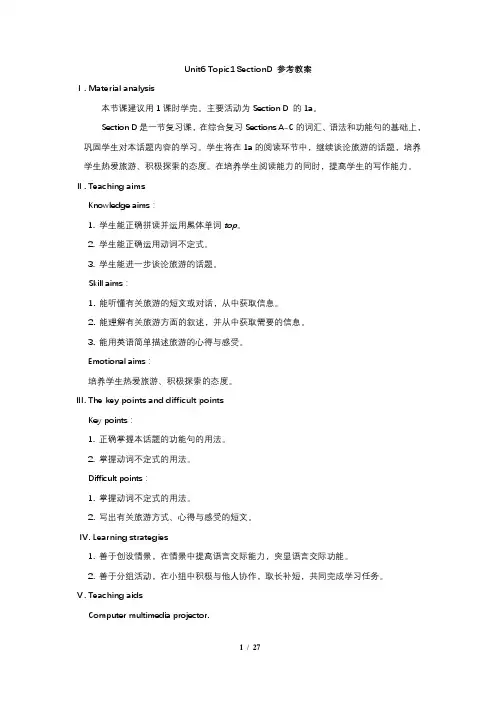
Unit6 Topic1 SectionD 参考教案Ⅰ. Material analysis本节课建议用1课时学完。
主要活动为Section D 的1a。
Section D是一节复习课,在综合复习Sections A-C的词汇、语法和功能句的基础上,巩固学生对本话题内容的学习。
学生将在1a的阅读环节中,继续谈论旅游的话题,培养学生热爱旅游、积极探索的态度。
在培养学生阅读能力的同时,提高学生的写作能力。
Ⅱ. Teaching aimsKnowledge aims:1. 学生能正确拼读并运用黑体单词top。
2. 学生能正确运用动词不定式。
3. 学生能进一步谈论旅游的话题。
Skill aims:1. 能听懂有关旅游的短文或对话,从中获取信息。
2. 能理解有关旅游方面的叙述,并从中获取需要的信息。
3. 能用英语简单描述旅游的心得与感受。
Emotional aims:培养学生热爱旅游、积极探索的态度。
Ⅲ. The key points and difficult pointsKey points:1. 正确掌握本话题的功能句的用法。
2. 掌握动词不定式的用法。
Difficult points:1. 掌握动词不定式的用法。
2. 写出有关旅游方式、心得与感受的短文。
Ⅳ. Learning strategies1. 善于创设情景,在情景中提高语言交际能力,突显语言交际功能。
2. 善于分组活动,在小组中积极与他人协作,取长补短,共同完成学习任务。
Ⅴ. Teaching aidsComputer multimedia projector.Ⅵ. Teaching proceduresⅦ. Blackboard designUnit6 Topic1 SectionD 参考教案Ⅰ. Material analysis本节课建议用1课时学完。
主要活动为Section D 的1a。
Section D是一节复习课,在综合复习Sections A-C的词汇、语法和功能句的基础上,巩固学生对本话题内容的学习。
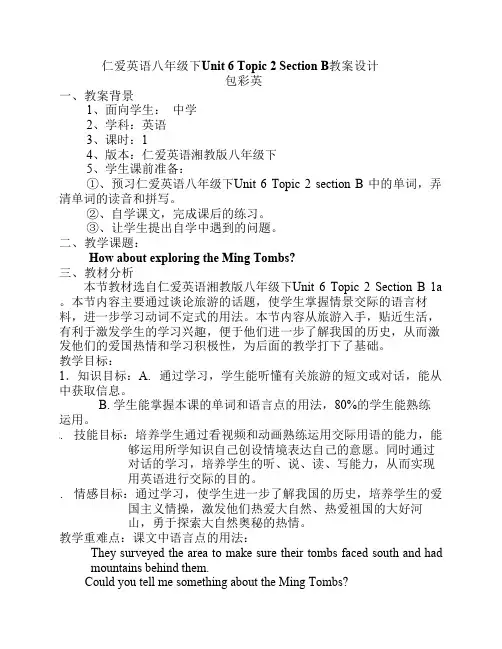
仁爱英语八年级下Unit 6 Topic 2 Section B教案设计包彩英一、教案背景1、面向学生: 中学2、学科:英语3、课时:14、版本:仁爱英语湘教版八年级下5、学生课前准备:①、预习仁爱英语八年级下Unit 6 Topic 2 section B 中的单词,弄清单词的读音和拼写。
②、自学课文,完成课后的练习。
③、让学生提出自学中遇到的问题。
二、教学课题:How about exploring the Ming Tombs?三、教材分析本节教材选自仁爱英语湘教版八年级下Unit 6 Topic 2 Section B 1a 。
本节内容主要通过谈论旅游的话题,使学生掌握情景交际的语言材料,进一步学习动词不定式的用法。
本节内容从旅游入手,贴近生活,有利于激发学生的学习兴趣,便于他们进一步了解我国的历史,从而激发他们的爱国热情和学习积极性,为后面的教学打下了基础。
教学目标:1.知识目标:A. 通过学习,学生能听懂有关旅游的短文或对话,能从中获取信息。
B. 学生能掌握本课的单词和语言点的用法,80%的学生能熟练运用。
2. 技能目标:培养学生通过看视频和动画熟练运用交际用语的能力,能够运用所学知识自己创设情境表达自己的意愿。
同时通过对话的学习,培养学生的听、说、读、写能力,从而实现用英语进行交际的目的。
3. 情感目标:通过学习,使学生进一步了解我国的历史,培养学生的爱国主义情操,激发他们热爱大自然、热爱祖国的大好河山,勇于探索大自然奥秘的热情。
教学重难点:课文中语言点的用法:They surveyed the area to make sure their tombs faced south and had mountains behind them.Could you tell me something about the Ming Tombs?at the foot of 、in the northwest of Beijingspread out、 on both sides ofIt’s about two and a half hours by bike.教学之前用百度在网上搜索明十三陵的相关教学材料,找了很多教案和材料作参考,了解到教学的重点和难点,确定课堂教学形式和方法。
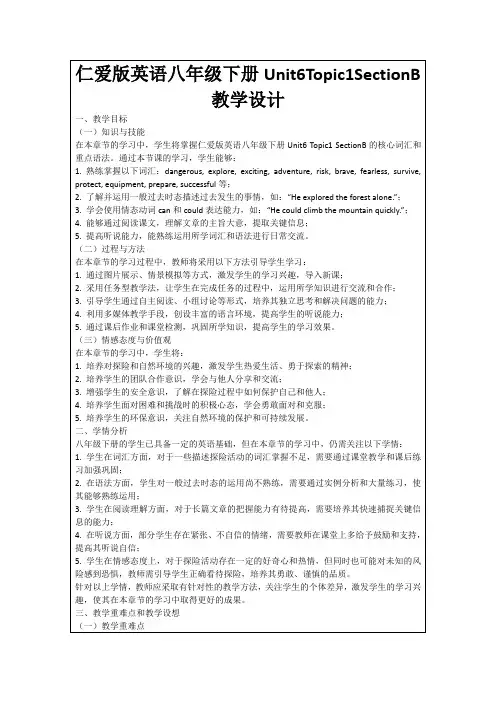
仁爱版英语八年级下册整册教案Unit6 Enjoying CyclingTopic 1 We’re going on a spring field tripSection A说课稿一、说教材1. 教材分析仁爱版初中英语教材共六册,每册由四个模块组成,每个模块由单元-———话题————功能——-任务构成,编写思路清晰,符合学生的认识发展规律.八年级英语下册第六单元Topic1 Section A讲述了让学生学习如何用英语谈论旅游,并收集旅游信息。
它由3部分组成,用1课时完成。
通过学习Section A,学生可以更多的了解旅游知识并提高实际能力;动词不定式是本节课的重点语法项目。
2.教学目标(1).知识目标要求学生牢记Section A所有新学的四会单词.短语和重点句型;掌握不定式“to do"的用法。
(2).技能目标:能用英语与他人谈论关于旅游的话题。
培养学生提高语言交际能力,能在小组中积极与他人协作,从而开阔自己的视野,扩大知识面.(3).情感目标培养学生爱护大自然,热爱旅游.积极参与课堂上各种英语实践活动的兴趣.培养学生分工合作和团体协作精神.3.教学重点和难点(1)。
重点:谈论关于旅游的话题。
(2)。
重点和难点:不定式“to do”的用法。
二。
说学情1.学生对旅游较感兴趣,但对旅游知识了解较少.2。
学生的词汇量掌握不多.3. 学生平时较少用英语与他人交谈并表达信息..三。
说教法学法按照课程改革的要求,遵循“老师由主演变导演,学生由配角变主角”的角色转换,采用把课堂交给学生的教学理论,我运用自由讨论。
分组工作.结对练习。
问答练习等方法,借助多媒体、录音机,图片等教学手段,设置特定的语言环境,使学生在轻松愉快的气氛中理解.运用英语。
四.说教学程序我设计了以下的步骤来训练学生的听.说。
读。
写的能力,尤其是他们“说”的能力。
(一)温故知新(1).请两位学生用上节课重点句型号,分别复述Unit 5 Topic3 Section D 1a(2).教师与学生之间进行问答对话,让学生谈论关于他们最喜爱的旅游方式.设计意图:巩固上节课学过的知识,为学习新课铺垫.(二)情景导入用多媒体展示一些关于旅游和交通的图片,来引起学生的兴趣,并由此教学本节课的新单词,如:field ,trip ,cycle ,vehicle ,airline等。
Unit6 Topic1 SectionA 参考教案Ⅰ. Material analysis本节课为该话题的第一节课,建议用1课时上完。
主要活动为SectionA的1a和3。
本单元教学内容主要围绕旅游和交通方面的话题展开。
话题一主要让学生学习如何用英语谈论旅游,如何用英语预订车票、房间,如何为旅游筹集资金、制订出行计划等。
动词不定式是本话题的重点语法项目。
本课通过让学生掌握旅游地点、交通方式和所需费用等常识,掌握黑体单词和短语field, proper,total, go on a visit to …和decide on…, 理解白体词汇mount, vehicle, airline, partner和suitable, 掌握动词不定式的用法,同时教育学生要学会制订计划;培养学生热爱旅游、积极探索的态度。
Ⅱ. Teaching aimsKnowledge aims:1. 学生能正确拼读并运用黑体单词。
2. 学生能正确运用以下短语造句:go on a visit to …, make a decision, too…to…和decide on…1/ 1213. 学生能自如地运用以下句式进行交流:I have some exciting news to tell you.We’re going on a three-day visit to Mount Tai.It will take us a few days to get there by bike.It costs …Let’s decide.We’ll decide on the best way to travel on our field trip. 4. 学生能简单地掌握动词不定式的用法。
Skill aims:1. 能听懂有关旅游的短文或对话,并从中获取信息。
2. 能使用英语与他人谈论关于旅游的话题。
3. 能理解有关旅游、预订等方面的叙述,并从中获取需要的信息。
初中英语八年级下第六单元教学设计初中英语八年级下第六单元教学设计一、教学内容分析教学内容为:《仁爱版八年级英语下册第六单元第一个话题Section A》。
本课谈论如何用英语预订车票及旅馆以及如何为旅游筹集资金、制定出行计划。
它由三个部分组成,用1课时完成。
通过学习Section A,学生可以更多的了解旅游知识并提高实际能力;语法内容主要有动词不定式作定语、表语、宾语、目的状语等,内容紧密相连,环环相扣。
二、学生学习情况分析1.学生对旅游较感兴趣,但对旅游知识了解较少。
2.学生的词汇量掌握不多。
3. 学生平时较少用英语与他人交谈并表达信息.。
三、设计思想对于农村学生,学英语的最佳环境只有学校、英语课堂,他们的听说读写能力主要是在英语课堂上及校内的课外兴趣活动中得到训练、提高。
本节课重点在于通过引导、启发,让学生自主探讨、合作学习去感知对话内容,分析、比较、归纳对话中出现的语言点、语法现象。
并以此框架为借鉴去模仿编写类似的对话(中下学生)或创造性地根据自己实际情况编写新对话(能力较强的学生),培养学生自主学习的习惯和综合应用语言的能力。
四、教学目标新课标指出要从英语学科的特点出发,激发培养学生的兴趣,帮助学生树立学习英语的信心,克服学习中产生的畏惧心理和困难,建立语感,掌握语言基本知识和技能。
所以,本节课的教学目标为:1、知识目标:要求学生牢记SectionA所有新学的四会单词、短语和重点句型;掌握不定式“to do”的'用法。
2、技能目标:能用英语与他人谈论关于旅游的话题。
培养学生提高语言交际能力,能在小组中积极与他人协作,从而开阔自己的视野,扩大知识面。
3、情感目标:培养学生爱护大自然,热爱旅游.积极参与课堂上各种英语实践活动的兴趣。
培养学生分工合作和团体协作精神。
五、教学重点和难点1、重点:谈论关于旅游的话题。
2、重点和难点:不定式“to do”的用法。
六、教学过程设计作为教育工作者,一个很重要的任务就是要消除“理想的学习结构”与学生“原有的学习结构”之间的差异,设计出“实施的学习结构”。
八年级英语(仁爱版)下册语言知识点归纳Unit 6 Enjoying RidingTopic 1 We’re going on a spring field trip一、重点词组1.go on a spring field trip 去春游2.a two-day visit to Mount Tai为期两天的泰山游3.make a decision 做出决定4.find out 查找;弄清5. bring back 带回6.decide on sth.对某事做出决定7.book some tickets/rooms 预定车票/房间8.the hard/soft sleeper硬卧/软卧9.pay for 付款10.make hotel reservation 预定酒店房间11.many kinds of rooms 许多类型的房间12.the best time to do sth.做某事的最佳时间13.work out the cost估算/算出费用14.do/go fund raising = raise money/ funds 筹集资金e up with 产生;想出;赶上16.get to (call home) 达到(打电话回家)的程度17.sell newspapers/ old books/ flowers 卖报/旧书/花18.not…any longer = no longer 不再19.enjoy a good trip 享受愉快的旅行20.at the foot of…在…的脚下二.重点句型及重点语言点1. … , we will go on a two-day visit to Mount Tai, …我们将去泰山进行为期两天的旅行。
two-day “两天的” , 这是带有数字的复合形容词,复合形容词用连字符号连接时,名词要用单数。
如:a 14-year-old boy 一个十四岁的男孩 a 100-meter race 一百米赛跑 a two-day visit 为期两天的旅行2. We will make the decision together. 我们将一起作出决定make a decision = decide 做决定decide (not) to do sth. 决定(不)做某事 decide on sth. 对某事做出决定3. Going by train doesn’t cost as much as by plane, and going by bus is not as comfortable as by train. 搭火车的费用没有搭飞机的高,搭公车不如搭火车舒适。
“going by train”动名词短语在句中做主语。
cost 表“花费(金钱/时间)”时,主语必须是事物。
常用句型“ sth. costs (sb.) some money/time”如:This bike cost me 300 yuan. 这本书花了我三百元钱。
Finishing the homework costs me two hours a day. 通常,每天做完作业花了我两个小时。
4. We’ve got tickets at ¥ 120 for the hard sleeper and ¥ 180 for the soft sleeper.我们的的票价是硬卧票120元,软卧票180元。
at 在句中表“以……的价格”. 如: We’ve got tickets at ¥80 for The Sound of Music.我们有80元一张的《音乐之声》门票。
5.I want to book 10 rooms with two single beds …我想订10间有两张单人床的房间… with 结构在句中作定语,修饰前面的名词,表特征。
如:a girl with light hair 一个金发女郎 a boy with big eyes 一个大眼睛男孩6 My school in America raised a lot of money for our band trip last year. 去年, 我在美国的学校为我们的团队筹集了很多钱。
raise 及物动词,表示“筹集”外,还表“举起;使升高”,一般指把某物从低处抬高到高处。
如:She raised her hand. 她举起了她的手。
He raised his glass to Mr. Li.他举杯向李先生祝贺。
rise 不及物动词,表示“上升;升起;上涨”一般指事物本身由低处移到高处。
如:The sun rises in the east. 太阳从东边升起。
The river/ price rose. 河水上涨了。
7. Some schools come up with great fund raisers , …一些学校产生出伟大的集资者,……come up with 表示“想出;产生;赶上”如:Suddenly he came up with a strange idea. 突然间他想出了一个奇怪的主意。
We came up with the train in time. 我们及时赶上了火车。
8. It takes students one yuan each to buy tickets for a draw to become king or queen for a day. 学生要想成为“一日国王”或“一日王后”, 就要花一元钱买票才可以参加抽奖。
此句型为“It takes sb. some money/ time to do sth.”花了某人多少钱/时间做某事。
三. 重点语法 (一) 结果状语从句1) … , so …“因此”, 常与because 引导的原因状语从句转换. 如:We don’t have much money, so we should go fund raising.= Because we don’t have much money, we should go fund raising.Helen is worried about her trip cost, so she is sad.海伦担心她的旅行费用,因此她很难过。
= Helen is sad because she is about her trip cost. 海伦很难过是因为她担心旅行的费用。
2) … so … that …“如此…以致于…”, 如结果表否定时,常与too + adj./ adv. +to do sth.句型转换.a) 主语 + be + so + adj. + that + 句子e.g: I was so tired that I couldn’t go on any longer. = I was too tired to go on any longer.The cost is so expensive that we should raise money.b) 主语 + 实义动词+ so + adv. + that + 句子e.g: He plays basketball so well that we all like to play with him. 他球打得如此好,以致于我们都喜欢他。
He got up so late that he couldn’t catch the bus. 他起床如此迟,以致他赶不上车。
= He got up too late to catch the bus. 他起床起得太迟了而不能赶上车。
3) … so that …结果e.g.: Jane often makes noise so that I can not fall asleep. 珍妮经常吵闹,结果我无法入睡。
(二) 动词不定式1) 作表语, 常用在系动词之后.Your group’s task is to find out the cost to go by train. 你小组任务是去弄清搭火车的费用。
She seems to be happy. 她似乎很快乐。
2) 作主语, 常用it(形式主语)代替, 不定式放在后面做真正主语. It is hard to say. 很难说。
It is important to learn English well. 学好英语非常重要。
4) 作宾语, 常用在want; like; hope; begin; try; forget; learn; plan; decide; need 等及物动词后,构成动宾结构。
I want to buy some books. 我想去买一些书。
She likes to join the English Club. 她喜欢加英语俱乐部。
We hope to be teachers. 我们希望成为教师。
Don’t forget to call me. 别忘了打电话给我。
5) 作宾补,6) 作定语常用在被修饰的名词/代词之后I have some exciting news to tell you.我有一些令人激动的消息告诉你。
I want something to drink. 我想要些喝的东西。
四、口语应用预订车票、房间:Can I help you? / What can I do for you?Yes. I want/ would like to book …Which kind of ticket o you want, the hard sleeper or the soft sleeper?What kind of room do you have?How many do you want?How much does …cost?May I have your name and your number?Topic 2 Let’s go exploring.一、重点词汇:1. death(动词) die2.east(形容词) eastern3.crowd(形容词)crowded4. huge(同义词) large5. push(反义词)pull 14. satisfy(形容词) satisfied 15.diary(复数)diaries(二)重点词组:1. have a vacation 度假3.cost too much 花费太贵4.plan a trip 计划旅行e along with sb.与某人在一起6. go to the cinema去电影院7. look forward to (doing) sth.期待做某事8. go camping去野营9. in the old days 在古代10.in one’s life在某人的一生11.on both sides of the way 在路的两旁12.two and a half hours两个半小时13.be crowded with 挤满了…14.be surprised at 对…感到惊讶15.push out 挤出;推出16.step on one’s toes 踩了某人的脚趾17.as soon as 一……就……18.give sb. a big hug 给某人一个拥抱19. have fun doing sth.做某事有乐趣二、重点句型及重点语言点1. I’m looking forward to meeting him. 我正盼望看到他.look forward to 表“期待, 盼望”, to是介词,后面应用名词、代词或动名词,且常用于进行时态。